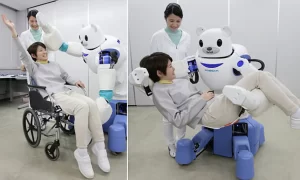Healthcare robotics, Nursing care robots review, types, advantages, disadvantages and uses
Robot nurses can help in repetitive tasks, such as medical supply retrieval, food and medication delivery, and patient movement and transfer. Robots can assist the training staff, The robot can simulate the behavior of a patient’s limbs during patient-transfer training. Healthcare robotics can save costs, it reduces facility waste, and it can improve patient care.
Robotics
Robotics is a branch of engineering and science that includes mechanical engineering, electrical engineering, and computer science. Robotics, mechatronics, industrial robots, and futuristic humanoids have penetrated many aspects of human lives. Robots can be used in the manufacturing industries, they can be used in dangerous environments, or in places where humans cannot survive for several years.
Robotics is used in many cities in public transportation where public transport systems including the undergrounds, over grounds, and metro services, are operated driverless and designed with full autonomy. Robots can be used in household tasks like room cleaning, food preparation, lawn mowing, and playing games with children. Robotics will increase research opportunities.
Healthcare robotics
Robots in healthcare include surgical, rehabilitation, and hospital robots. they can include surgical robot training, exoskeletons, smart prostheses and bionics, robotic nurses, and robots that can assist with therapy, pills, logistics, telepresence, and cleaning, Healthcare robotics comes with gesture control, machine vision, speech and voice recognition, and tactile sensors.
Robot Dinsow
Robot Dinsow is used by Thai and Japanese hospitals for patient care, It monitors elderly patients via video and sets up video chats with their relatives, It can alert caregivers of patient activity by phone, it offers reminders for medication and exercise and exercises alongside the elderly, it entertains by offering games and karaoke.
Robot Paro
Robot Paro is used in hospitals and extended-care facilities the world over, It stimulates interaction between patients and caregivers, It helps to relax patients by imitating the voice of a baby harp seal, it adapts to patient behavior in part through its five sensor types: light, audio, temperature, posture, and tactile. Robot Paro helps to reduce patient stress, improve their relaxation and motivation, and improve their socialization with caregivers and their peers.
Robot Pepper
Robot Pepper is a humanoid robot, It works in the reception area of two Belgian hospitals, greeting people and guiding patients to their proper departments. Robot Pepper can recognize 20 languages and can identify gender and can identify joy, sadness, anger, and surprise. It has an interpret non-verbal cues like head tilts, frowns, smiles, and shifts in vocal tones.
Robot Pepper “sees” through two high-resolution cameras and a 3D camera, It is equipped with shape recognition software that processes captured images. It has twenty engines and three multi-directional wheels that allow the robot to move at a maximum speed of 3 km/h, and its six laser sensors, It has two ultrasound transmitters, and three obstacle detectors in its legs to help it identify the distance of objects within a 3-meter range.
Nursing-care robots advantages
Service robots can be used in nursing or care homes, they can take care of older adults. there are about 5,000 nursing-care homes testing robots for use in nursing care due to the declining number of human nurses to care for aged people (above 65 years of age). Robot nurses allow providers to offer their healthcare services at a lower cost, Robot nurses can reduce the cost of human labor per year.
The need for robotic telemedicine will increase, as patients living in rural areas or those in urgent need of a specialist can receive a diagnosis and treatment plan via a robot controlled remotely through a desktop, laptop, or mobile device. Robots nursing can transcribe and store crucial medical information that reduce the error as well as helps doctors and nurses diagnose patients.
The nursing robot system is designed to assist bedridden patients with simple services, It is confined to the patient’s room in the hospital or at home. Nursing-care robots can carry out laundry services as well as other household chores, and with a human-like voice for greeting patients awakening from sleep.
Robot nurses are quicker to train, cheaper to maintain, easier to refuel and repair, and they can do very odd and repetitive tasks, Robotic nurses can do most of the boring and dangerous nursing jobs that may result in occupational exposure of human nurses to hazardous infections or chemicals.
Robots nursing can be helpful in continuous monitoring of patients and data collection for emergency cases like heart failure and diabetes and then relay such data to a human nurse or doctor for action to be taken. Robots nursing can help older adults and ill patients to remain independent, reducing the need for carers and the demand for care homes.
Robots nursing can address cognitive decline issues by reminding care-receiver when to eat, drink or take medication, do exercise, or attend an appointment. nursing-care robots do many tasks with a high level of accuracy and constantly, even during holidays or night working hours.
Nursing-care robots disadvantages
Nursing Robots assure a high level of productivity and efficiency at reduced costs in comparison with humans, nursing-care robots become an attractive alternative for healthcare providers, The additional reduction of people interested in becoming a nurse could deprive our communities of fundamental medical assistant skills. The usage of robots should be taxed to limit the use of nursing-care robots.
Nursing robots come with surveillance equipment to monitor their patients, record the related data and communicate information wirelessly. Nursing robots can safeguard aged patients by establishing virtual proximity with their relatives or healthcare providers, but they could lead to a violation of patients’ privacy. Without adequate regulations or, in their absence, responsible corporate policies and protocols, Nursing robots can represent a threat to the private life of patients and all the individuals that interact with them.
Robots come with safety & security issues, the manufacturers have to face the predictability issue and invest resources to identify all the potential hazards that the implementation of nursing-care robots can entail. safety & avoidance of harm should be of importance in the healthcare domain when using robots because of the involvement of vulnerable people such as ill and older adults and children.
How to keep robots safe from being hacked is another concern of security. it is important to check the activities of hackers who might exploit the technology for nefarious activities. Robots have programming that allows them to understand emotions and exhibit a proper response. The robot’s programming can cause delays in ethical decision-making when it’s faced with an unusual circumstance – something that could potentially affect a person’s life.
Nursing-care robots have mechanical nature, so, it is impossible to attribute their liability in case of malfunctioning or any other adverse consequence related to their usage, such a task could become impossible taking into consideration the age and the vulnerability of the individuals who are supposed to make use of nursing-care robots. The issue of accountability is made more complex by the developments in artificial intelligence and its applications for robots. nursing-care robots come with artificial intelligence that makes them autonomous giving them decision-making capabilities.
The removal of human caregivers from the care environment and their replacement by nursing robots cause rise to many issues related to the dignity and the happiness of the patients. The very presence of a human entails the patient’s value of recognizing him or her as a unique individual rather than an impersonal entity. This can’t be replaced by a nursing robot because of its “mechanical,” “pre-programmed” and “neutral” way of interacting with patients. Robots can’t replace nurses in healthcare and allow patients to interact with humans, especially where they are particularly sensitive or vulnerable.
The importance and uses of robots in medicine
Robotic surgery cons, pros, uses and How does robotic surgery work?
Artificial intelligence in Medical field advantages and How AI medical diagnosis changes medicine
Surgical robot types, advantages, disadvantages, How is robotic surgery different from traditional
Applications of Artificial intelligence in the medical field and healthcare
Importance of Artificial intelligence in healthcare and medicine
Domestic robot or Service Robot types, advantages and disadvantages




